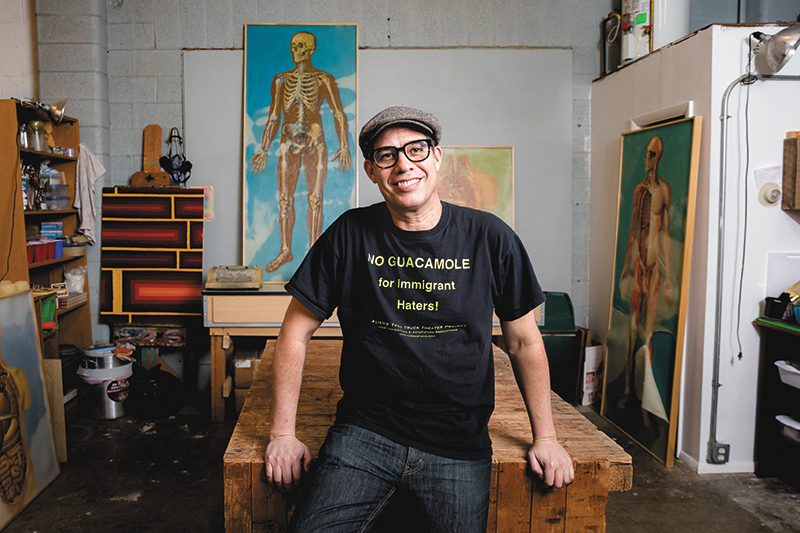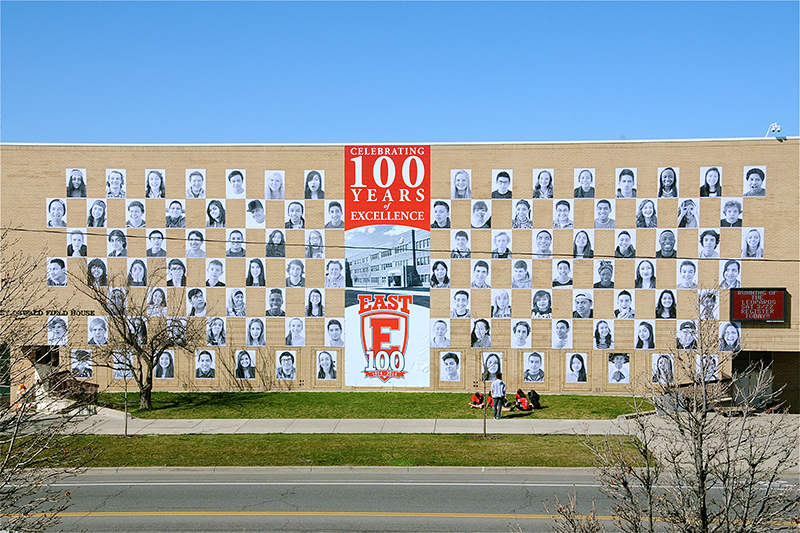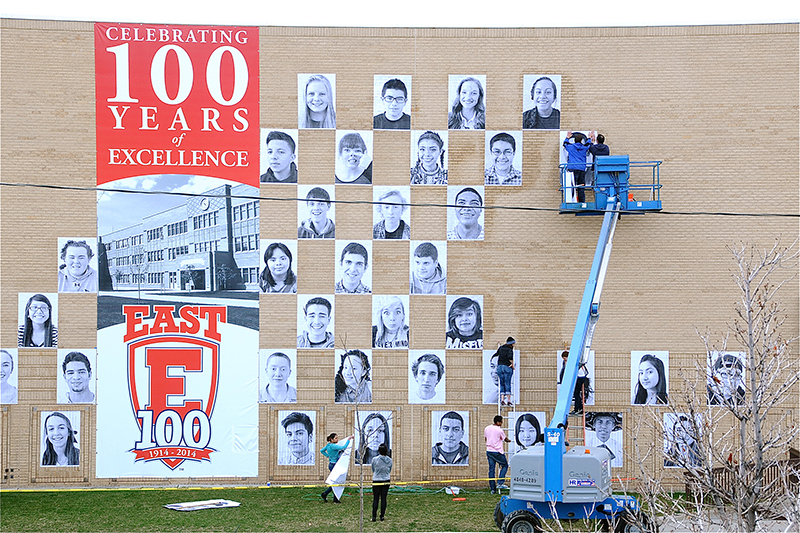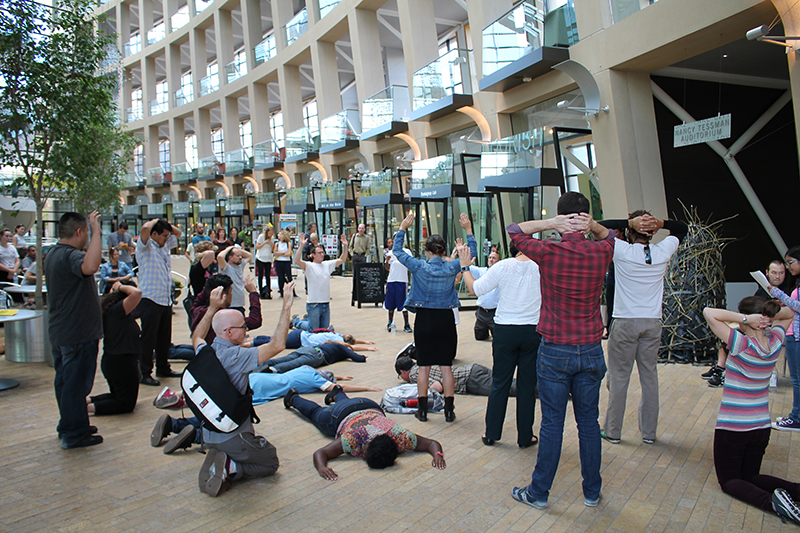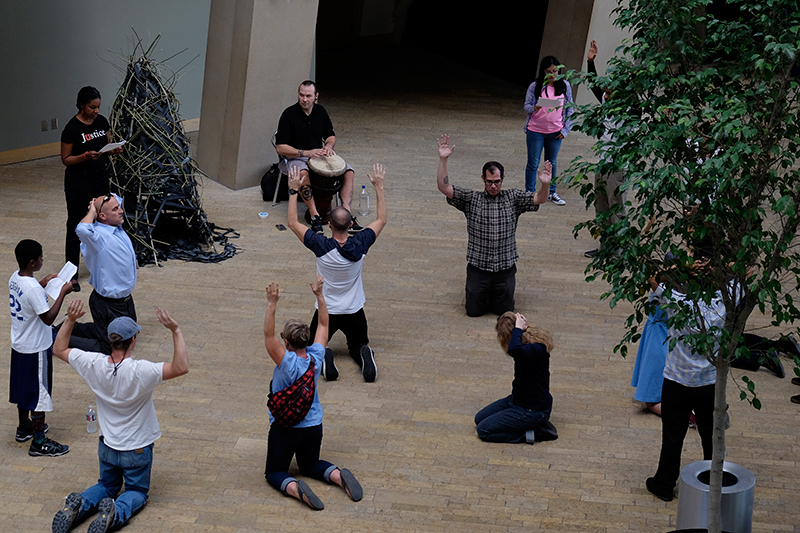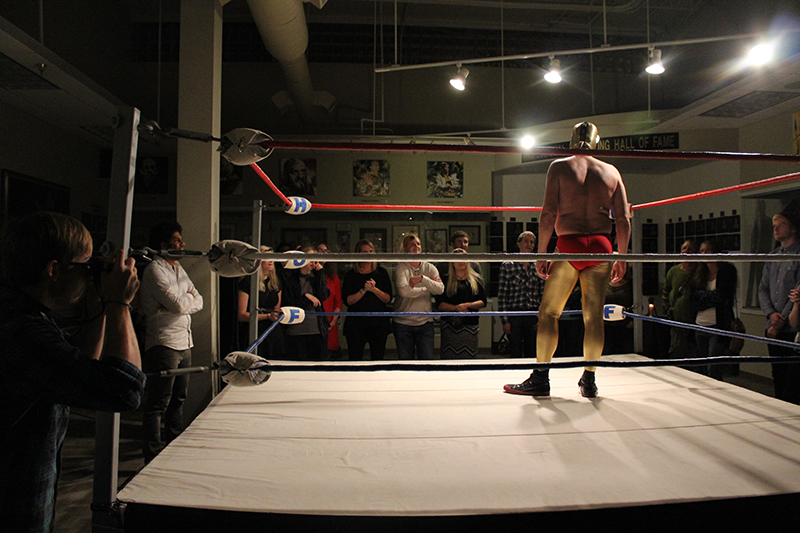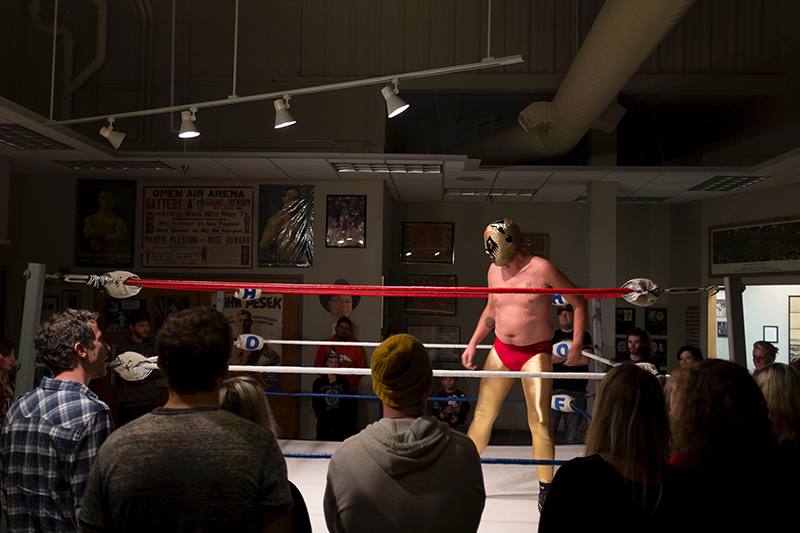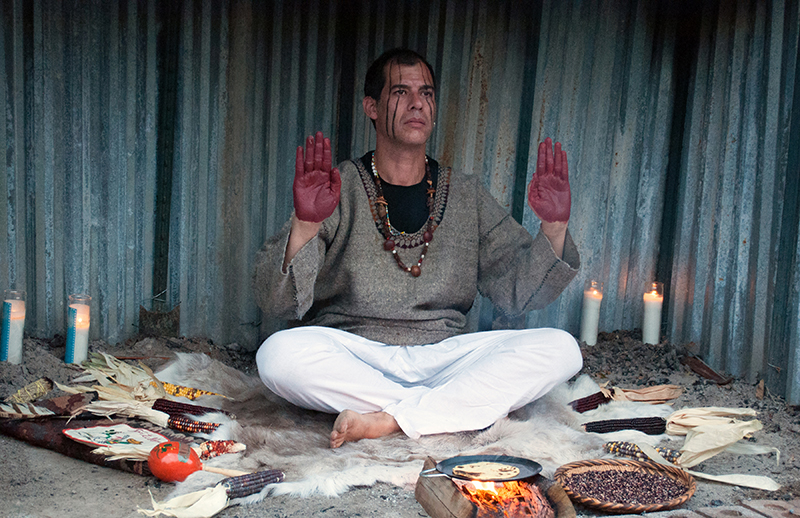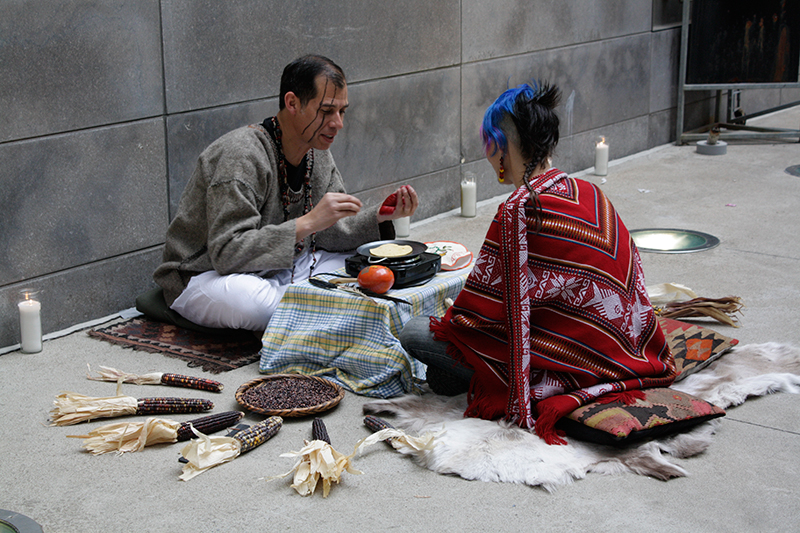Personal/Public: Artist Jorge Rojas on Performance
Art
Jorge Rojas’ artistic practice delves into the realms of the personal and the public—their intersections, blurring overlaps and fringes. For the last 10 years, Rojas has focused on performance art, veering between intimate moments and dramatic gestures, drawing from lived and shared experience, intercultural and contemporary identity, and much more. His pieces range from the voyeuristic My Space, in which audiences watch Rojas live and work inside a tiny room, to the discomfiting 99 Cent Facelift, in which Rojas uses tape to distort his face. In Lucha Libre, Rojas enters with bravado as luchador before delivering an audience address and enacting a puppet show; and in Tortilla Oracle, Rojas divines corn tortilla markings, inviting, as shaman, a sacred one-to-one ritual and exchange. Imbued in Rojas’ artistic practice and career are education and community. In SLC, he’s taught at East High School and oversaw the We Are One Inside Out project, which celebrated the school’s diversity. After becoming Director of Education and Engagement at the Utah Museum of Fine Arts, Rojas helped launch the ACME—Art, Community, Museum and Education—program, elevating the public role of the museum.
Ahead of a class at the University of Utah, upcoming UMFA events and more artistic projects, Rojas reflects on his performance practice and beyond.
SLUG: How did your pathway to art begin?
Jorge Rojas: I was born into a very creative and artistic family of musicians, dancers, singers, and writers. I think I subconsciously chose the visual arts to set myself apart from the rest of my family. My best friend in high school was an artist and a source of inspiration. I studied art in college, but it wasn’t until I moved back to Mexico to go to art school that I decided to pursue a career in art. I moved to New York City to follow my dream of being an artist and have never looked back. Art was the only field of study that I knew I wouldn’t lose interest in and that would always challenge me.
SLUG: You’ve led workshops and classes in NYC, at East High School, and now, at the University of Utah. What drew and draws you to art education?
Rojas: After living in NYC for a few years and having waited tables for a very long time, I decided the only way I could live with myself was to get some kind of job in the arts. I got a job as a teaching artist through the Brooklyn Arts Council, which placed me in numerous public K-12 schools teaching students how to paint murals. I had a lot of bad teachers growing up, so I figured I at least had a good sense of how not to teach.
Teaching started out for me for as a way to make ends meet, but with time, I fell in love with it and the ability to influence and empower young people, especially disadvantaged youth. After moving back to Utah and being a stay-at-home dad for a few years, I got a job teaching art history at East High School through the Clemente Humanities Course, an interdisciplinary humanities course for underserved high school students. Art History and the humanities are the best way I know to inspire students to discover and develop their own voice, creativity, identity and cultural pride. They are the best tools I know to help students realize that they possess the power to affect change in their families, schools, communities, and the world. I’m super excited and grateful for the opportunity to be teaching Art in the Community this Spring through the University of Utah’s Art and Art History Program. I used to struggle with finding a balance between teaching, curating and making art, but now I am comfortable knowing that they are all part of my practice and that they each inform and support each other.
SLUG: You created a multi-year, international, online platform (lowlives.net) to broadcast performance art. What did you learn from Low Lives?
Rojas: The most important thing about Low Lives, for me, was its experimental nature and the excitement that came from taking risks throughout the creative process. Most of the themes addressed in these performances, each in their own way, explored aspects of our human and social makeup, as well as our complicated relationship with technology. I get asked regularly when I’m going to relaunch the project. I think the idea of Low Lives is even more relevant now than it was during its first five years, so we’ll see.
SLUG: Your work has spanned painting and sculpture to new and mixed media to performance art, community interactions and “interventions,” and digital platforms. What mediums are you most working with recently? I’d love to hear about what ideas or concepts have been marinating on your mind lately, too.
Rojas: My focus for the last 10 years has been on performance art. I’m excited to develop a project that I’ve been thinking about for years. It incorporates many of my interests, including participatory performance, live streaming media and real life. I don’t want to give too much away, but think the movie Slackers: set in Salt Lake City, casting non-actors, very loosely scripted and captured and live-streamed with GoPro cameras. I’m sure the money for this will just come rolling in. LOL! I plan to spend more time in my studio this year making stuff out of wax and sandpaper. I also just bought a new camera, so I’m excited to play with that.
SLUG: You’ve helped spearhead multiple community efforts, from Planned Parenthood’s The Art of Safe Sex to a fundraiser for Comunidades Unidas. In 2016, you presented the participatory piece Hands Up Don’t Shoot! in solidarity with Black Lives Matter. How is performance art so impactful for engaging audiences with such topics?
Rojas: There is a long history of performance and/or performative acts used in protests and demonstrations. The physical proximity and immediacy of the artist’s body is part of it. It’s right there in front of the audience—no stage, no division, no protection. I think performance is the most direct and confrontational form of art, and the most vulnerable. It requires a great deal of courage, psychological strength and, in some cases, endurance. When done right, performance is hard to ignore.
SLUG: What do you feel is the duty/responsibility of the artist, if any, when presenting works that address social justice issues?
Rojas: I can’t speak for anyone else, but my responsibility as an artist is to be true to myself and to my art. It’s also my responsibility to be informed about the work I make.
SLUG: I’m interested in hearing your feelings regarding Utah’s artistic landscape, and where your work fits in. I’m also interested to hear about where you feel Utah’s artistic landscape has the most room for growth.
Rojas: I’m not sure if my work “fits” within Utah’s artistic landscape. I do know that many people here have supported my work. What excites me is our city’s potential to invest in the visual arts as a way to engage, uplift, and transform our community into something greater.
Rojas: I love the way you hold space in your performance pieces, from the one-to-one encounters in Tortilla Oracle to your audience address (and puppet show!) in Lucha Libre. Can you talk about how the space you hold is also one that you trust your viewers to share?
Rojas: I’m interested in holding spaces that invite sharing, engagement and intimacy. This requires trust and intent on both sides. When people enter into a space with me, they can sense that I am committed to what I’m doing; not just to my performance, but also to the exchange we’re about to have. Performance can be personal. Performance has taught me that people yearn to be seen for who we are. Not the selves that we present regularly at work or in our social lives, but our deeper selves, who we really are. My hope is that performances like Tortilla Oracle and Lucha Libre provide space for these types of exchanges to occur and that the experience we share continues to resonate with the audience well after the performance.
SLUG: In U of U Associate Professor Elena García-Martín’s essay, “Foreign Bodies in the Performance Art of Jorge Rojas,” she recounts how you mention that, aside from possibly NYC, you haven’t necessarily felt a sense of belonging to any country or place. You mention that your body and your mind, and so your performance, is your home. I’d love for you to elaborate on this idea.
Rojas: My family moved a lot when I was growing up, back and forth between Mexico and the U.S., almost every four years. This made me think a lot about what is home, place and belonging. Growing up between these two countries was challenging because I was not “white” enough for Utah and not “brown” enough for Mexico. Because of this, I experienced racism in both countries. These experiences helped shape who I am, and being an “outsider” made me become very observant of both cultures and their customs, something that has served me well as an artist. So when I say that my body, mind and performance are my home, I mean that I am in a space of my own making, my own creation, a space in between.
SLUG: What have been some of your favorite projects?
Rojas: My Space, Low Lives, Tortilla Oracle, Lucha Libre, 99 Cent Facelift, Hands Up Don’t Shoot!, We Are One Inside Out project at East High, and ACME @ UMFA.
SLUG: What have been some of your most recent triumphs?
Rojas: I don’t know if I’ve had recent triumphs, but I’m most proud about being a father and helping raise two amazing young boys. I’m proud that I have a job that I love, where I’m constantly challenged to be creative, and where our work can affect change in our community. Teaching Art History to high schoolers as part of the justice-themed Clemente Summer Camp at Westminster is very rewarding. I serve in some amazing arts-based organizations that inspire me every day and keep me grounded in what matters, including Mestizo Institute of Culture and Arts (MICA), Artes de Mexico en Utah, Utah Network for Arts and Social Justice and the National Performance Network/Visual Artist Network (NPN/VAN), an organization that believes all communities deserve broad access to art and culture that reflect their own experiences and inform the experiences of others.
SLUG: What advice might you have for emerging artists?
Rojas: Trust your process. Create your own path. Don’t depend on the acceptance of established systems to measure your success. Mine your life, culture and personal experiences for ideas. Do what you love. Make art about what you know.
SLUG: How did you conceptualize the UMFA’s ACME Lab?
Rojas: ACME stands for Art, Community, Museum and Education. It was designed to help the UMFA rethink the public role of the museum, and to become a more accessible, inclusive and community-centered space. The Lab promotes collaboration between museum and community through active participation and collaboration—providing an avenue for mutual learning, discovery, and understanding. By calling it a Lab, it automatically communicates that we embrace experimentation—in this case, around learning, teaching, and engaging with art and with each other. It says to our community, “We don’t have all the answers. We want to learn from and with you.”
SLUG: How do you select the collaborative artists, researchers and other creatives for each ACME Session, and from there, develop their specific projects?
Rojas: ACME Sessions are about strengthening community through strategic partnerships committed to identifying and amplifying the most creative voices and minds in our community. Sessions address current issues through the lens of art, education and community. Session leaders are selected by either reaching out to people we’ve identified in the community and on campus, and people reaching out to us because they’ve attended a session and want to utilize the platform to highlight their own work or research, or to build discussions around issues they are passionate about. We have a great partnership with the Salt Lake City Public Library and receive additional support from Utah Humanities. We just had our 11th ACME Session and have already partnered with over 40 community organizations. All this learning through collaboration helps our museum understand what types of programming we need to work on to be more relevant to our community.
SLUG: The upcoming ACME Lab session features a collaboration with Epicenter, the Green River, Utah–based organization that engages in design-based practices to support the residents, businesses and artists within a town of 961 people. Could you elaborate on what this installation will involve for attendees?
Rojas: Yes. I’m so excited for this project. In Epicenter’s Our Futures ACME Lab, visitors are invited to “time travel” through this interactive, hands-on installation to explore possible futures for the town of Green River. This fun and futuristic “case study” asks visitors to speculate the future of their own towns—and to examine the role they each play in creating it. The show opens March 2, and will run through July 1.
SLUG: What upcoming projects (February and on) can readers look forward to at the UMFA?
Rojas: We have some great free programming happening at the UMFA in conjunction with the Go West! exhibition. Go West! examines the development and disruption of the American West through more than 80 original artworks by Euro-American and Plains Indian artists. These artworks illustrate how newcomers mythologized their vision of the region while Native peoples sought to preserve their vanishing way of life. We created Now West!, a series of free programs accompanying the exhibition, to encourage dialogue and critical thinking around this consequential period in American history.
We’re excited to bring historian Gregory Hinton to the museum to offer his survey of LGBT history and culture in the American West. Emma Hansen, Curator Emerita and Senior Scholar of the Plains Indian Museum at the Buffalo Bill Center of the West, will offer a presentation exploring Native arts of the Great Plains as powerful expressions of senses of place based upon cultural knowledge, oral traditions, spiritual beliefs, and deep relationships to distinctive homelands. And as part of our film series partnership with the Utah Film Center, we’ll be screening Through the Repellent Fence, a documentary that follows Native American art collective Postcommodity as they construct Repellent Fence, a two-mile long outdoor artwork straddling the U.S.-Mexico border a mile in each direction and suturing the region back together. Repellent Fence is an ambitious artwork that gives voice to the shared history and enduring culture of Indigenous societies that have made the region their home for thousands of years before a border ever divided it.
Keep up to date with Rojas’ current and upcoming projects via Facebook, and visit umfa.utah.edu for more information about their Epicenter’s Our Futures ACME Lab and the Now West! program series.
